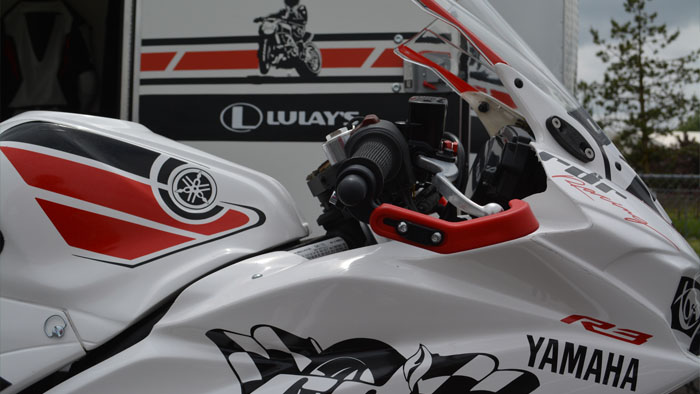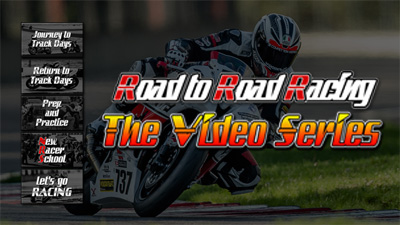 Race Prep
Race Prep
Road to Road Racing : Step-by-Step
Race Gear Prep / Race Bike Prep / Pit Prep
I reviewed the 2019 OMRRA rulebook to determine the requirements for gear, bike, and pit setup. Prior to getting on the track on race day, you must pass inspection to make sure you, your bike, and your pit are in good condition to safely compete.
Race Gear Prep
Fortunately in 2018 I had upgraded everything and my full gear setup meets the requirements. Unfortunately, I did crash on the last corner of the last day of 2018 - so tested it out... and fortunately the gear all held up great and nothing needed to be replaced.
- One Piece Suit - see my Heroic Suit Compared to Cortech and Bilt 6:11 minutes
Note: you must keep your medical form in your suit at all times.
- DOT or ECE Certified Helmet
Each helmet you plan on wearing must go through tech for an evaluation and a sticker that will be placed on the helmet.
- Three Strap Gauntlet Gloves - see my Heroic Gloves Compared to Alpinestars and XTI 3:45 minutes
- Boots
In my first season I was wearing SIDI boots, but in 2018 I switched over to white TCX air boots after spending the year seeing Mark Degross' sweet boots;
- Back Protector - CE Level 2
See my Gear Prep page for more details.

Race Bike Prep
A good general review of bike prep (not race bike prep), see the Bike Prep section in our Journety to Track Days area.
Since I am putting out the effort, it made sense for me to race prep both my R3 and R6 (even though I only plan on racing my R3 initially).
I am blessed to have friends that were willing to help me with Race Bike prep, so I headed over to M-Tech Motosports in Bend Oregon and caught up with Mark Degross (2Fast) and Andrew Cox (Cox Racing Group) to help me with that tricky safety wire stuff.

- Race Body
I've installed lots of bodies, but this was my first time installing a race body. The type that I bought didn't even have holes in them, so I had to locate and drill holes and then I riveted the DZUS quarter turn fasteners to make it easier to take the pieces on/off more quickly. The bid reason you have to get a race body is the need to have a belly pan that will capture all of the fluids in case of a leak or catastrophic failure.
- Safety Wire
It is important that your stuff stays on your stuff and not on the track, so safety wire is required - read the rulebook to find the specific parts that must be wired.
Nut/Bolt Holes
If you can afford it... just buy the pre-drilled nuts/bolts (but that is pretty expensive); or you can find a machine shop and take the nuts/bolts to them which I found to be cheaper than buying most of the pro bolts; or you can buy a whole bunch of bits (I bought 20) and enlist your friends to help drilling (this takes a long time and I would have broken them all myself - but I had friends that knew what they were doing.
Safety Wire
I found safety wire pliers on eBay and after I saw they worked well, I ordered another for my trailer tool box. Mark Degross and Andrew Cox have done this a million times, so I got to watch and learn how to do this from them. I recommend looking up YouTube videos for a reputable shop and specifically focus on how to lead the wire in the bolt's tightening direction.

- Fluids
Remove Anti-Freeze
You have to remove the anti-freeze and replace with distilled water (many recommend Water Wetter, which is the additive that I mixed with the distilled water to help the bike run cooler. Mark Degross and Andrew Cox helped me prep mine for racing while at M-Tech in 2019. Also see a video we did for J2TD at Cycle Country in 2017 that covered a full street coolant replacement 5:04 minutes. NOTE: you have to safety wire your cap and your drain plug, so plan on drilling and safety wire when you do anti-freeze.
Brake Fluids
While servicing my fluids I also opted to replace my lines with wrapped and stainless lines to improve performance and feel. Andrew handled my Yamaha R3 and Pearce Lutz did my Yamaha R6 in his garage.
See a video we did for J2TD at Cycle Country that covered brakes and brake fluid 15:44 minutes;
Make Sure No Leaks
Check all fluid entry/exit/connection points for leaks and address any issues;
- Remove Kick Stand
You cannot race with a kickstand, and remember that most bikes have a kill switch hooked to the kickstand to prevent you from accidentally riding with the kickstand down, so you will need to re-wire the kick stand so the bike will start with the kickstand off... don't do this at the track, and do it properly... because if you get a short months later you may not immediately know to look for this wire.
- Brake Lever Guard
This required piece is supposed to help prevent your brake lever from accidentally getting squeezed (causing an endo) in the event of a collision into the lever. There are lots of poor solutions for this and again I opted to use some of the best - Woodcraft brake and clutch guards that attach firmly to the bar ends (note: they would not have worked with the OEM clip ons, but I am running Woodcraft clip ons on my bikes).

- Chain/Sprockets
Make sure your drive system is clean and properly lubed, and the tension is good;
- Toe Guard
This required piece is supposed to help prevent a part of your body from getting caught up between the chain and sprocket. I ordered toe guards from Woodcraft that attach to the swingarm (note: they required drilling the swing arm);
- Transponder
If you are going to race you will either have to buy or rent a transponder - which sends a signal to track your time and position as you ride around the track. It mounts on your bike's fork.
- Bike Sound
Maximum sound limits vary between tracks, so it would be wise to make sure you have options to reduce your noise in the event a track deems your bike is exceeding their noise limits. Baffle inserts or quieter slip ons are nice to keep handy just in case.
- Tires
I upgraded my tires from Bridgestone RS10 to their new R11 tires for NRS and the racing season (running them on both my R3 and R6). Bridestone recommends using tire warmers with the R11 tires, so I also purchased some Woodcraft tire warmers.

Pit Prep
Most pit areas are easy to identify by EZUPs, and you will generally see the teams connecting their EZUPs.
- Fire Extinguisher
Each team pit area is required to have a fire extinguisher in a visible location. If you aren't on a team, you can find affordable extinguisher options at the larger chain stores.
- Pit Sign
Each pit area is required to have a number sign to make it easy for staff to be able to idendify where each racer is located;
- Trailer Prep
In 2018, I made significant upgrades to my trailer to handle hauling more bikes and improving my pit area to be better prepared at the tracks. See my trailer and truck sections for upgrades.


